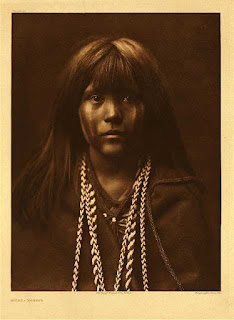So I just read a biography of Edward S. Curtis called
Short Nights of the Shadow Catcher: The Epic Life and Immortal Photographs of Edward Curtis. He was quite an impressive guy; he went from day laborer to top photographer of the rich and famous in Seattle, to dealing with President Teddy Roosevelt and J. P. Morgan, all within just a few years.
 |
This is said to be the image that convinced
J. P. Morgan to finance Curtis' project. |
His big mission was to record the ways of the American Indians before they were either eliminated, or assimilated into western ways. His inspiration may have begun when he photographed the daughter of Chief Seattle, who was an elderly lady living alone in poverty in Seattle at the time. He thought he could produce 20 volumes in 5 years that would cover it. His 20 volumes ended up taking about 20 years, costing him all his money and a marriage.
He travelled from Alaska to Arizona to Oklahoma befriending the Indians in order to be let in to their traditional ceremonies. Often he would make several visits over a period of years to gain their trust. His goal was to record their religious beliefs, their ceremonies, and their daily way of life using photos, audio recordings and text. He was most disappointed with Oklahoma, where the Indians had already lost much of their traditional life and were trying to assimilate to the white man's ways.
 |
| Haschebaad - Navaho |
In 1914, Curtis even made a silent film to try to raise some badly needed money for the project, but ran into problems with the distribution. The film was called
In the Land of the Head Hunters, (sometimes retitled as
In the Land of the War Canoes) and though critically-acclaimed, it never made back his initial investment. (At the time of writing,
it's available on YouTube.) It directly inspired the director of the later groundbreaking film
Nanook of the North (
also on Youtube) which is considered the first ever full-length documentary, although we would now call both films docudramas, as some things were staged. Both films, however, tried to capture the actual life of the native people.
 |
| Nature's mirror - Navaho |
Luckily for us, Curtis' masterwork is now available online, courtesy of Northwestern University, at
The North American Indian online...
...and volume 1 has been digitized in several formats by Gutenberg.org, here:
The North American Indian, Vol. 1 at Gutenberg.org, for those of you with e-readers. It's not just about the photos; the books are full of stories about his experiences with the natives.
 |
| A sea-otter hunter |
Buy some Edward S. Curtis books from Amazon:





Comments
Post a Comment